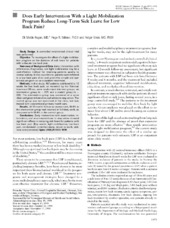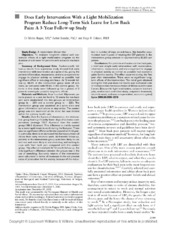| dc.contributor.author | Hagen, Eli Molde | |
| dc.date.accessioned | 2006-03-09T18:07:21Z | |
| dc.date.available | 2006-03-09T18:07:21Z | |
| dc.date.issued | 2006-02-03 | eng |
| dc.identifier.isbn | 82-308-0101-0 | eng |
| dc.identifier.uri | https://hdl.handle.net/1956/1126 | |
| dc.description.abstract | Background: During the last decades there has been a major rise in sick leave due to low back pain, emphasising the need for interventions preventing chronicity and long term sick leave. Early intervention with information, advice, reassurance, and encouragement to stay active may be a cost-effective method for returning patients quickly to normal activity. Aims: 1) To study if an early intervention at a spine clinic with information, reassurance, and encouragement to stay active may reduce sick leave for subacute low back pain (sick listed 8- 12 weeks). 2) To evaluate short- and long-term clinical and cost-benefit effects. 3) To identify predictors and modifiers of treatment effect influencing sick leave. 4) To investigate if low back pain complaints are specific or part of a more general unspecific condition comparable to subjective health complaints in the normal population. Material and methods: 457 patients sick listed 8-12 weeks for low back pain with or without radiating pain and age between 18-60 years were included. The patients were randomised into an intervention group (n=237) and a control group (n=220). The intervention group was examined at a spine clinic by a treatment team consisting of a physician (specialist in physical medicine and rehabilitation) and a physiotherapist. The main purpose of the intervention was to provide the patients with coping skills to manage their back pain through information for better understanding why the pain was not dangerous, and why activity was important despite the pain. The patients were given time to express their concerns and explain how the back problem affected their life and daily activities. They were given practical advice in how to resume normal activity, and they were encouraged to stay active. The control group was treated within the primary health care. All subjects filled out questionnaires. Data on sick leave, disability, and other social benefits were collected register data from the National Insurance Offices. Finally, the subjective health complaints scored by all the subjects in the study group at inclusion time were compared to reference values from a Norwegian normal population, consisting of 1240 adults. Results: The intervention program had significant effect in reducing sick leave. At 3-months follow up 51.9% of the patients in the intervention group had returned to full-duty work, as compared with 35.9% in the control group. At six months 61.2% in the intervention group vs 45% in the control group had returned to work, and at 12 months 68.4% in the intervention group vs 56.4% in the control group had returned to work. (Paper 1). Over the 3 years of observation, the intervention group had significantly fewer days of sickness compensation (average 125.7 d/person) than the control group (169.6 d/person). The difference was mainly caused by a more rapid return to work during the first year. The intervention had economic gains for the society. Net benefits accumulated over 3 years of treating the 237 patients in the intervention group amount to approximately NOK 6 049 649 ($ 828 719). (Paper 2). At three months follow up predictors for non-return to work, both subgroups (intervention and control group) combined, were other illnesses, the belief that work would aggravate the condition, pain when performing daily activities, and age below 41. The strongest modifying effect of the intervention on return to work was the perception of constant back strain when working and beliefs about reduced ability to work. At 12 months follow up predictors for nonreturn to work, both subgroups (intervention and control group) combined, were other illnesses, less than 12 years of education, low belief that back pain would disappear, and being a female. The strongest modifier for the effect of the intervention on return to work was gastrointestinal complaints. (Paper 3).Compared to the normal reference population, the low back pain patients had significantly more low back pain, neck pain, upper back pain, pain in the feet during exercise, headache, migraine, sleep problems, flushes/heat sensations, anxiety, and sadness/depression. The prevalence of pain in arms, pain in shoulders, and tiredness was also high, but not significantly higher than in the reference population. (Paper 4). Conclusion: Early intervention with examination, information, reassurance, and encouragement to engage in physical activity as normal as possible reduced sick leave for subacute low back pain and had economic gains for the society. The effect occurred during the first year after intervention. There was no increased risk for reoccurrence of sick leave due to low back pain over the next 2 years in patients returning early. The intervention was short and simple and seemed to have a main effect on work absenteeism via interacting with concerns of being unable to work. Patients suffering from low back pain also have other complaints, and these comorbid conditions may influence the prognosis, in particular the trust and ability to return to work. The intervention may have its main effect via the perception and interpretation of the condition, and the concerns underlying the decision to return to work. | en_US |
| dc.format.extent | 2544835 bytes | eng |
| dc.format.mimetype | application/pdf | eng |
| dc.language.iso | eng | eng |
| dc.publisher | The University of Bergen | eng |
| dc.relation.haspart | Paper I: Reprinted from Spine, 25, Hagen EM, Eriksen HR, Ursin H, Does early intervention with a light mobilization program reduce long-term sick leave for low back pain?, pp. 1973-1976, Copyright 2000, with permission from Lippincott Williams & Wilkins | eng |
| dc.relation.haspart | Paper II: Reprinted from Spine, 28, , Hagen EM, Grasdal A, Eriksen HR, Does early intervention with a light mobilization program reduce long-term sick leave for low back pain? A 3-year follow-up study, pp. 2309-2316, Copyright 2003, with permission from Lippincott Williams & Wilkins | eng |
| dc.relation.haspart | Paper III: Reprinted from Spine, 30, , Hagen EM, Svensen E, Eriksen HR, Predictors and modifiers of treatment effect influencing sick leave in subacute low back pain patients, pp. 2717-2723, Copyright 2005, with permission from Lippincott Williams & Wilkins | eng |
| dc.subject | Subacute low back pain | eng |
| dc.subject | Randomised controlled study | eng |
| dc.subject | Return to work | eng |
| dc.subject | Co-morbidity | eng |
| dc.subject | Subjective health complaints | eng |
| dc.subject | Predictive factors | eng |
| dc.subject | Light mobilization | eng |
| dc.title | Light mobilization treatment of subacute, non-spesific low back pain | eng |
| dc.type | Doctoral thesis | |
| dc.subject.nsi | VDP::Medisinske Fag: 700 | nob |
| dc.subject.nsi | VDP::Medisinske Fag: 700::Klinisk medisinske fag: 750 | nob |



